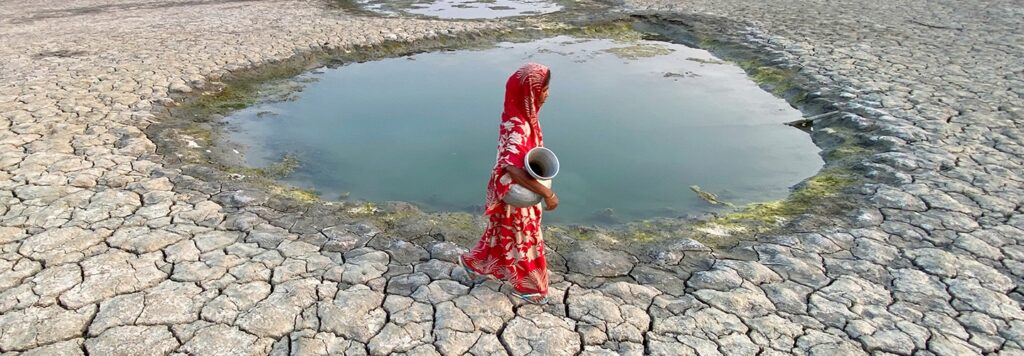Perspective on Building Protection, Not Just Response
By Vishal Pathak

Photo credits: Ab Rashid/UNDP Bangladesh
As the world prepares for COP30 in Belém, Brazil, the conversation on climate change is finally shifting from crisis to capability—from measuring losses to financing adaptation that lasts. The call from developing nations is clear: adaptation is not charity; it is investment in shared survival and development.
For over three decades, the All India Disaster Mitigation Institute (AIDMI) has advanced this vision from the ground up. Across India’s cities and small towns, adaptation is already happening—not in conference halls, but in fruit markets, schoolyards, around bus depots, and coastal fishing hubs. Here, communities are crafting their own responses to extreme heat, floods, and unseasonal rains. The question for COP30 is not whether adaptation is possible, but whether the world will choose to fund it at the scale it deserves.
Adaptation Stories from Small Businesses
India’s approach to adaptation is both ambitious and practical. The National Disaster Management Authority (NDMA), National Adaptation Fund for Climate Change and the recent concrete progress for National Adaptation Plan provide frameworks that link disaster risk reduction, public health, and climate resilience. State governments—from Odisha’s cyclone shelters to Gujarat’s Heat Action Plans—have demonstrated that prevention costs less than recovery. At the local level, municipal corporations and panchayats are now taking ownership. Ahmedabad’s Heat Action Plan, and implemented with local health teams, is one of the world’s most studied adaptation models. It has inspired dozens of cities across South Asia.
Through initiatives like Resilience fund and Afat Vimo (disaster insurance), AIDMI has supported over two thousand small businesses to prepare for extreme heat, unseasonal rain, and floods in eleven cities across India, these small businesses building their understanding on extreme heat, early warning and cool solutions to protect their health, households and businesses including their clients. Small investments – fans, cool roofs, shade nets, cool storage, changing behaviours, food, and clothes habits, relocation and changing working hours and diversified income source that provides cool services to clients and many more such actions and measures – resulted in better productivity, reduced loss and damage, protecting health protection, and diversified income.
These examples embody what COP30 calls for: climate justice through local leadership. Adaptation succeeds when it respects people’s priorities, integrates gender and livelihoods, and bridges science with everyday experience.
Adaptation as Livelihood Protection
Through initiatives like the resilience fund, AIDMI has supported thousands of small businesses and transportation workers to prepare for extreme heat, unseasonal rain, and floods.
In Ahmedabad alone, more than 400 businesses have adopted “cool solutions”—installing shade structures, reflective paints, better and cooler storage and fans.
“We used to close by noon because of the heat,” says Bhavnaben Dantani, a fruit vendor. “Now, with shade and water, and required change in routine practices, we can keep working safely.”
These are not isolated successes. They demonstrate how climate adaptation can strengthen local economies while preventing avoidable deaths and losses.
Through our partnership with the Avoidable Death Network (ADN), AIDMI is capturing such examples under the scheme of the Ahmedabad Case Station for Avoidable Deaths (ACASA)—turning local data into policy insights for global learning.
Financing Adaptation Before the Crisis
A central message for COP30 must be that adaptation finance is development finance.
The world continues to invest heavily in post-disaster relief, but underfunds prevention. Global disaster costs are now estimated at USD 2.3 trillion annually, while only 2 % of official development assistance is directed to risk reduction.
India is showing how to reverse this imbalance. The upcoming 16th Finance Commission is expected to raise domestic DRR and adaptation allocations. Meanwhile, the G20’s High-Level Principles for Investment in DRR, endorsed under South Africa’s presidency, will further encourage private-sector resilience investments.
Our on-ground experience supports this momentum: even small, flexible funds can transform communities’ ability to act early. When small businesses provide a small amount of support with focused orientation and education before extreme heat to install cooling materials, they avoid far greater losses later. This is what “funding resilience” truly means.
From India to Brazil: What COP30 Can Learn
For COP30, we are emphasizing the following five points drawn from our recent experience with working with affected-populations who are adapting to climate extreme events:
- Adaptation is most effective when local: Cities and communities must shape their own responses, supported by subnational and national frameworks.
- Finance must be anticipatory, not reactive: Adaptation funds should reach people before climate shocks, not after.
- Health is central to adaptation: Heat, disease, and occupational safety must guide climate policy.
- Women and small businesses are key actors: Their innovations form the backbone of resilient economies.
- Knowledge must flow both ways: Local solutions—like cooling practices—should inform global adaptation metrics and finance design.
These lessons show that adaptation is not a distant ideal but a daily practice already underway in the Global South.
Conclusion: A Constructive Path Forward
Adaptation is not only about adjusting to change; it is about shaping it. The communities AIDMI works with are not passive recipients—they are co-creators of resilience. When local governments, civil society, and global partners act together, hazards cannot become disasters, and development progress remains secure.
For COP30, we are carrying this conviction: that true climate ambition lies not in promises of compensation but in investments that protect life, work, and dignity before crisis strikes.
Adaptation is the bridge between knowledge and justice, between what we know and what we must now do. From Ahmedabad’s shaded markets to Belém’s global stage, it is time to move from responding to rebuilding, and from building to belonging in a resilient future.
Vishal Pathak, vishalpl@aidmi.org, www.aidmi.org, All India Disaster Mitigation Institute (AIDMI).
